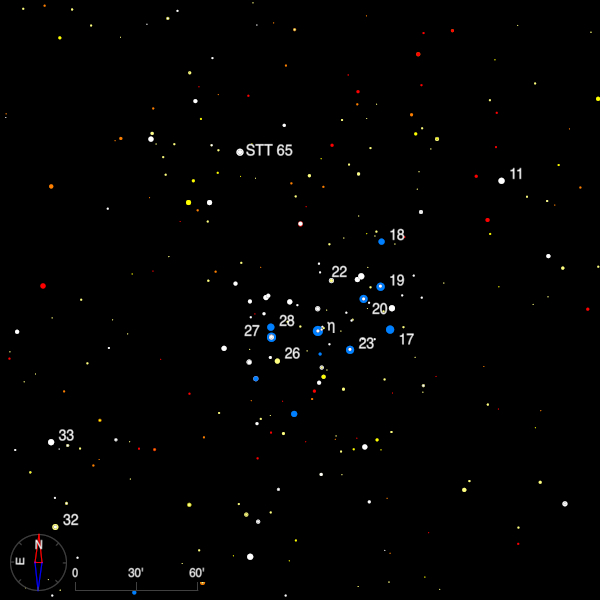December 2021 - Double Star of the Month
STT 65 (03 50 18.9 +25 34 47) is close visual pair about 2 degrees north-east of the Pleiades but which does not appear to be part of the cluster. Although the compilers of Gaia EDR3 decline to pronounce on the value of its parallax, the Hipparcos mission found it to be less than half the distance to the Pleiades at 184 light-years.

The pair was discovered by Otto Struve using the 15-inch refractor at Pulkova in the 1840s and it has been followed regularly ever since the orbital period was found to be relatively short (it is currently thought to be 61 years). The orbit is highly inclined and quite eccentric which means that the apparent distance between the stars ranges from 0".03 (in 1996) to almost 0".7 in 2033. At the end of 2021 the stars will be 0".59 apart and thus within range of a good 20-cm aperture, although there is a significant difference in magnitudes between A and B - 5.7 and 6.5 respectively.
Located in the narrow part of Eridanus which squeezes between Fornax and Horologium, is the K giant star y Eri (magnitude 4.6). Half a degree east is the fine pair DUN 15 (03 39 45.49 -40 21 08).

Since John Herschel's measure in 1836, the distance has increased from 4".0 to 7".5 at the current time, whilst the position angle has reduced from 335 degrees to 327 degrees. The stars are both of spectral class A and the Washington Double Star Catalog (WDS) gives the V magnitudes as 6.9 and 7.7. This does seem to be a physical pair as the Gaia EDR3 catalogue lists a parallax for each star which is the same (mean value 4.70 mas = 694 light-years) within the errors.
Moving 1 degree ESE from DUN 15 will bring the observer upon HJ 3589, an unequal pair of magnitures 6.5 and 9.3 with position angle 350 and a current separation of 5".0 but which appears to be slowly decreasing.
Bob Argyle - Double Star Section Director